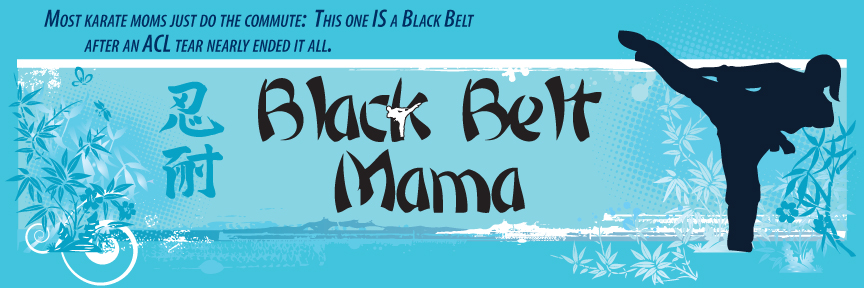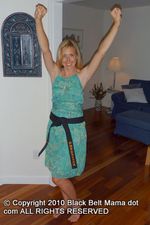October 4, 2018
Nintai…It Runs in the Family
The kanji design that is the heart and soul of this site has been my mantra for a long time. . . nintai. Persevere. It was the kanji hand painted onto the crutches that got me through three knee surgeries . It was the thought always in my head as I worked on flexion at PT and celebrated each accumulating degree. It was the motto of the move that took me away from my family, friends, swim team, and dojo. You just keep putting one foot in front of the other. You can get through anything if you just keep going.
So it seems only fitting that my 1000th post would be about perseverance as well. But today, I don’t want to write about all I have persevered through. Instead, I’d like to write about Swim Girl, my senior in high school, my beautiful, smart and talented 17-year old who first made her “blog character” appearance 12 years ago, in 2006, as “Big I.” Although I took a writing hiatus, her early years were documented here. And during that hiatus, she has really grown up.
Swim Girl has always loved swimming, even when she was not so great at it. After moving to VA, she began trying some longer distance events and discovered that she was pretty good at swimming them. For a while, she continued to drop time in those events. I looked forward to her swimming the 1650 free, because it was fun to see how much time she could drop. And then the drops came to a halt. Swim Girl described the same thing after every race. She felt like she couldn’t breathe, that her throat was closing up, that there was a lump in her throat preventing her from breathing. It was during allergy season when she first described these symptoms, so I didn’t think much of it. She was diagnosed with exercise-induced asthma when she was younger. I figured the allergies were just exacerbating the asthma.
Then, just weeks before Senior Champs of her sophomore year, there was a chlorine chemical spill at her practice facility. Six of our swimmers had to go to the ER, including Swim Girl. She felt like her lungs had been fried. After ER breathing treatments and two rounds of steroids, she started to feel a little better. But her events at Senior Champs were nowhere near where they should have been time-wise. She entered her Junior year, hoping for better days ahead.
As her Junior year started, Swim Girl couldn’t help but wonder why she always seemed the most out of breath at practice. She had barely taken a break between seasons and was attending all practices. She started to feel frustrated, but thought that maybe the hot pool and air temp were contributing to her asthma difficulties. She never seemed to get the lanes with the “good air,” so she figured it was a combination of things and kept on going.
During an October meet, where she was put in multiple distance events, I watched her fade back in the 1650, her splits completely off of where she should have been, even for an early season meet. When she finished the race, she was purple. She described the same feeling again, and we decided we needed a doctor’s appointment to reevaluate her asthma inhalers and make sure that her lungs had healed from the chlorine spill. It was during this appointment that our pediatrician suspected Swim Girl was suffering from Vocal Cord Dysfunction. The tight feeling in her throat was her vocal cords getting a message from her brain to close instead of open when she needed to breathe most. We were referred to a pulmonologist to confirm the diagnosis.
After a pulmonary function test, we met with the pulmonologist and he confirmed that Swim Girl had a classic example of VCD. He showed us a pulmonary function test graph that indicates a diagnosis of VCD. He then showed us Swim Girls’. They were identical. At first, we were relieved to have some answers. I figured there was a medication they could give her and it would stop. But unfortunately, with VCD, that is not the case. There is no medicinal cure. To double-check that there was nothing else going on, the pulmonologist referred us to an ENT doctor and her team which included a speech therapist. They put a small scope with a camera into Swim Girl’s throat to see her vocal cords. The diagnosis was confirmed once again. In the absence of any visible problem, VCD was the culprit.
We were referred to a speech therapist so that Swim Girl could learn how to breathe in a different way to combat the VCD attacks she would get while swimming. We spent two months going to appointments, where she focused on “belly breathing,” and on learning ways to stop (or at least minimize) an attack when it happened in the water. The challenging part is that quick inhales (imagine trying to take a fast sip) while swimming can be counterproductive. Swim Girl’s speech therapist told her that she needed to slow down during practice until she had mastered the new way she had to breathe. “No,” she told him, “I’ll just figure out how to swim fast and do it.”
Instead of doing her “double” practices with her team, she began doing some of them on her own at the local YMCA so she could slow down and work on her breathing. Sometimes the breathing techniques worked and sometimes they didn’t. Sets with little rest were torture for her. Without having time to reset her breathing, she would end up spending an entire practice just trying to calm her breathing back down. Sometimes, she began seeing spots and feeling like she would pass out. Swim Girl’s speech therapist told her that stress can make VCD worse, so he worked with her on relaxation techniques as well.
Physically, she was struggling with trying to figure out how to implement her breathing techniques during certain strokes (breast and fly for example); and mentally, she was struggling too. Her speech therapist continued to encourage and pump her up, and she was attending at least 7 practices a week at this point AND was doing extra practices on her own at the YMCA plus working out with her trainer. At practice, she focused on backstroke since she had figured out the breathing for that stroke. She didn’t feel it was possible to try to figure it out with the other strokes, not at a team practice.
Swim Girl started doing her own research into her condition. There had to be something she could do that would help. She found research studies that cited a different inhaler having an impact due to its anti-inflammatory properties. We made an appointment with the doctor and Swim Girl presented the study and got her inhaler switched. She also read many articles about how many swimmers with VCD found that it was too challenging of a condition to continue swimming. She wasn’t going to let VCD make her quit. She found a blog of a swimmer who had VCD and started reading her posts. This swimmer put herself on a gluten free diet and it seemed to help. That week, we were at the grocery store, restocking our pantry and changing the way our entire family eats. Swim Girl was working so hard and we wanted to support her efforts in any way we could.
At Senior Champs during her Junior year, Swim Girl dropped from a 2:12.92 in 200 back to a 2:07.19. She went from 63rd place to 9th, and then scratched into the “A” final. She needed a 2:05.99 to make her NCSA Junior National cut. Swim Girl spent the afternoon doing all of the things she needed to do to get ready for finals. . . ice bath, heating pads, water, healthy foods, a nap. She told me she could go faster than she had in the morning and I believed her. She talked out the race and told me where she could cut time on her start, turns, etc. I went to the lobby to give her some peace and quiet. I returned back to our hotel room to pack up and get back to the pool. Swim Girl was pumped up and positive. I told her I believed she could do it, and I did.
That night, Swim Girl dropped more time, to a 2:06.99, exactly 1 second off of the Jr. National time she was chasing. She took 3rd place overall, after being entered in 200 back with a bonus time. From 63rd to 3rd is pretty remarkable. We had a celebratory dinner that was preceded by some tears. She had been through so much. It would have been amazing if that one extra second could have been gone. She had started the year with a 2:15 in 200 back. To get to a 2:06.99 was a big accomplishment. While the Jr. National team competed in FL the following week, Swim Girl went to practice and continued to work on her backstroke and breathing techniques. After all of this, we were surprised when her name was announced as the 15-16 Female Swimmer of the Year at our team banquet.
At a long course meet in May, Swim Girl dropped a considerable amount of time in her backstroke events. She finished 1/4 of the pool ahead of her competition. On the last day of the meet, Swim Girl had to swim the 400 IM, an event that made her VCD flare up almost worse than the 1650. As I timed her and cheered her on, she was fading back and fast. She didn’t look good and I kept trying to watch her breathing. I knew she was having issues. She finished with a huge time add. Her lips were blue. She struggled to get out of the water and staggered to a wall. I left her alone so she could concentrate on her breathing. The stridor from her VCD was so loud, you could hear it four lanes away. It took her a solid 15 minutes to get her breathing under control again. When she could finally talk, she told me she started seeing spots, and then almost all black. The distance events had to go. In the locker room, she heard girls from another team discussing how she had “died” in the race. She was embarrassed and frustrated. It was time for a change in her training.
Heading into Senior Champs, she felt positive again after training in a new location. For the first time at a championship meet, Swim Girl had fun, swam relaxed and fast, and had an enjoyable meet. She knocked some serious time off of her 50 free and finally had a breakthrough in 100 breast.
This past August, Swim Girl began training full time with a new coach. She made him aware of her condition, and he asked how he could help. The first few weeks, Swim Girl swam a little slower so she could really concentrate on her breathing techniques and get her year started off right. Her coach built her confidence back up and supported her efforts. As the weeks have gone on, her breathing has become easier and her VCD flare-ups are rare. The environment that has allowed her to take care of herself has been so good for her. Her new coach told me that while some kids find ways to get out of doing things, she is continually looking for ways to keep doing things. He said she never stops at practice. He recognizes what a hard worker she is, and how much effort she puts into practice.
Over 90 colleges and universities have reached out to her so far, to recruit her for swimming. More emails come every week. She has narrowed down her choices and has spoken to all of the coaches about her condition, and all of the coaches have been supportive of her. After meets, they call or text and ask her how she did and how she felt. No one has crossed her off of their recruiting list because of her condition. Instead it has almost been the opposite. They see her drive and desire to stay in the water, even with circumstances that don’t make it easy for her. They see how she has continued to drop time in her events, and how she turned herself into a sprint and mid-distance contender when distance had to be taken off the table.
I see a girl who has always had to fight for it, a girl who gets her little brother off the bus and takes him to KidWatch at the Y so she can get another workout in. I see a girl who has made a gluten free diet a permanent choice, a strong girl who takes such delight in upping her weights at the gym. I see a girl who has maintained a 4.5 GPA throughout high school while getting up at 3:50 a.m. for practice every weekday. I see a girl that has been chosen as the Visual Arts Student of the Year and/or the Photography Student of the Year every year she has been in high school. I see a girl who was chosen to be President of the National Art Honor Society at her school. She is a triple threat: academics, athletics, art. I see a girl that loves swimming, a girl that is unstoppable. Perseverance is in her blood.























Oh my god, this post made me so angry at that fucking coach (SO SORRY BUT IT HAD TO BE SAID) that I want to drive to VA and drown him. Someone like that should NOT be working with athletes, and especially not children. I cannot imagine how many sleepless nights you had, being infuriated at him. ARGGGH! I’ve never met you in person, I only know you here and on FB, and still, I felt this story so strongly. I am so glad that your daughters are swimming at the right place now, and that she is thriving. She is an amazing girl.
Too many sleepless nights to count, J. Too many. And thank you for your outrage, because there are way too many people who just don’t even care as long as their kids are not being targeted (for the time being).